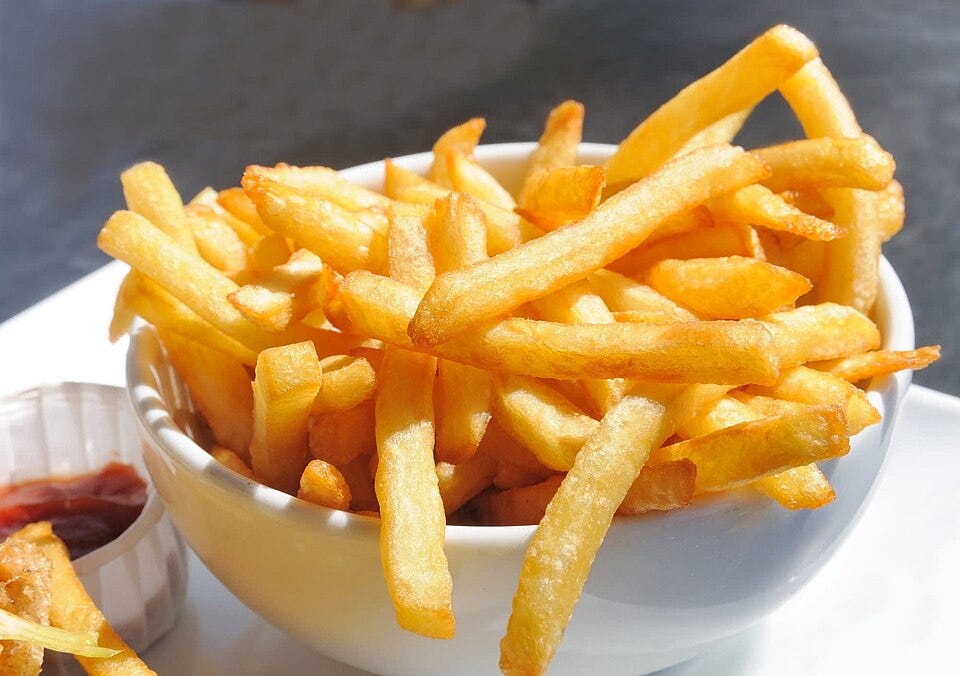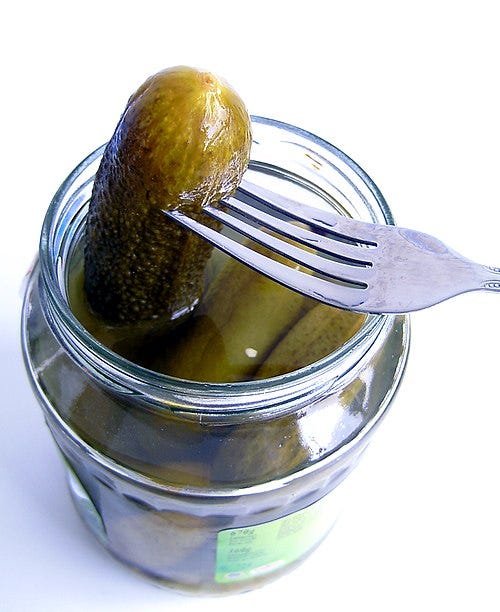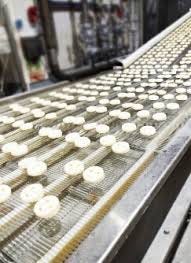How Indian French Fries and Gherkin Pickles Came to be Sold in New York Delis
As exports of French fries show, building a cold chain can save a third of India's vegetables and fruits from being wasted says Sunil Mani
(Photo: French fries. Courtesy Wikimedia Commons.)
By Sunil Mani*
July 20, 2025
For centuries, foreigners have sourced food items from India. In fact, the country has supplied pepper, cardamom, and other spices to foreign markets since ancient times, with documented trade routes dating back over 4,000 years. The direct European maritime access to Indian spices - which spurred invasions of the country by the Portuguese, French, and British - began in the late 15th century.
India continues to be a major exporter of food items. For instance, it is the largest exporter of beef, meat of water buffaloes, and Basmati rice. In fiscal year 2024-25, India exported nearly $4 billion of beef, mainly to Malaysia, Vietnam, Egypt and Iraq.
In recent years, India has emerged as a major exporter of two processed food items: crunchy pickled cucumbers, or gherkins, and bags of frozen potato slices, which, when cooked, turn into golden French fries. Both are sold in Parisian bistros and New York delis, served with burgers and ketchup sauce, as well as in supermarkets across Europe, the United States, Japan, and the Middle East.
India is the leading producer of cucumbers, accounting for more than 40% of the global output. In fiscal year 2024-25, India exported $307 million of pickled cucumbers. This is in addition to exports of pickled mangoes and lemons to the Indian diaspora.
Key foreign buyers of Indian gherkin pickles include Kraft Heinz, McDonald's, and Burger King in the U.S.; major European supermarket chains like Aldi, Carrefour, Tesco, and Sainsbury's; and pickle brands including Mt. Olive Pickles, Vlasic, Kühne, Hengstenberg, and Gedney.
The foreign buyers typically source supplies from major Indian processors such as Global Green Company, of the MTR Group, Freshara, Chennai, Vigneshwar Exports, Tirunelveli, and Nilon's, Pune. The cucumbers are mainly exported as bulk-preserved items in vinegar, brine, or acid, for final processing abroad; and partly as finished bottled or canned pickles.
Across the sun-baked fields of Karnataka, Tamil Nadu, Andhra Pradesh, and Telangana, roughly 90,000 small and marginal farmers cultivate cucumbers for export on about 65,000 acres. They own small plots, typically half to two acres in size. With cucumbers, they achieve two to three harvests each year, in 90-to-120-day cycles, turning marginal farmland, though with the key advantage of irrigation, into high-value organic farming.
The exported cucumbers differ from those sold in India. They originate from special seedlings cultivated for their size, crunch, and uniformity. The farming is labour-intensive and needs to meet quality standards, particularly the zero-pesticide-residue norms required by the U.S. and European Union.
Roughly 90% of the cucumbers are collected by the major processors directly from the fields. They are then transported in refrigerated trucks to more than 60 plants located in Krishnagiri, Tamil Nadu, Bengaluru Rural, Karnataka, and elsewhere. At the plants, the cucumbers are graded, washed, brined, and packed for export.
As small farmers, the cucumber growers have limited bargaining power with the processors, particularly in negotiations over prices paid, volume, and quality standards. The prices - and hence the profits - received by the farmers fluctuate widely since they are based on volatile international prices.
Each day, India's Agricultural and Processed Food Products Export Development Authority, APEDA, publishes the international benchmark price for gherkins. But there is no data from APEDA, or any other agency, that enables the comparison of the international price to that paid to the farmers.
The situation is worse for cucumber farmers in remote regions in Andhra Pradesh and Telangana. There local brokers buy cucumbers at volatile spot prices, often a quarter to a third below the prices paid by processors, and resell them to processors. Some of the brokers, being money-lenders, trap the small farmers in cycles of high-interest debt, 24% to 36% annually, and force them to sell cucumbers at low prices to repay the loans.
(Photo: Gherkin/cucumber pickles. Courtesy Wikimedia Commons.)
India’s cucumber pickle exports began in the early 1990s, when enterprises like Nilon’s and Global Green sought to meet demand from supermarket chains in Europe seeking cheaper supplies. Using government subsidies, they built bulk-processing plants and cold chain infrastructure to source cucumbers from farmers in Karnataka and Andhra Pradesh.
In the case of frozen French fries, in recent years, India has rapidly shifted from being an importer to an exporter. In fiscal year 2024-25, exports were $215 million, up sharply from $10 million four years earlier.
The foreign demand is mainly from McDonald’s, Burger King, and other global fast-food restaurant chains as well to serve consumers in Saudi Arabia, Oman, the Philippines, Malaysia, Thailand, Indonesia, and Vietnam. Recently, exports have also been shipped to Japan and Thailand.
The Indian subsidiary of Canada’s McCain Foods alone accounts for more than 40 per cent of the domestic processing and export capacity for frozen French fries, according to The Indian Express. Other exporters include Indian companies such as HyFun Foods and Iscon Balaji Foods.
The processors have to make significant investments to set up the production facilities as well as a cold chain, comprising of refrigerated storage and transportation. They mainly serve the domestic market, with exports being an add on business. For instance, McCain and HyFun supply the bulk of the fries sold by McDonald’s India.
Indian companies though are at a disadvantage, since, being a commodity product, they do not yet operate at the large scale needed to reduce costs. They rely heavily on low-cost loans from the State Bank of India, Punjab National Bank, and other government-run banks. In addition, the exporters benefit from government incentives; farmers also benefit from being covered by government-backed crop insurance schemes.
(Photo: a McCain Foods frozen French fries production line in India.)
Most of the plants processing potatoes for exports are in Gujarat, particularly in the Mehsana and Banaskantha districts. They source supplies from about 12,000 to 15,000 growers farming 60,000 to 75,000 acres, mainly high-solid potato varieties like FC-5 and Atlantic, according to The Hindu. Such farming is also expanding in Punjab’s Jalandhar and Ludhiana districts, where exporters offer seeds, farming advice, and fixed buyback prices.
Cultivation is costly since it requires irrigated fields, specific seed varieties, and meeting closely monitored agricultural practices and storage conditions. Although they are large farmers, the potato growers, like the cucumber farmers, have little bargaining power with the exporters on prices, volume, and quality.
The sourcing of potatoes for exports is also similar to that for cucumber exports. About 90% of the potatoes are bought by exporters under contracts from farmers. They pick up and transport the potatoes to their plants, where they are graded, washed, sliced, frozen, and packed to be shipped abroad.
In the emerging farming areas of Punjab, which account for a tenth of exports, the potatoes are sold to brokers, The prices paid are usually a quarter below those paid by the major exporters. With some of the brokers also being moneylenders, some farmers are trapped in high-interest debt. However, unlike cucumber farmers in the Southern states, potato farmers in Punjab can secure government-backed low-interest loans.
McDonald’s entry into India in 1996 spurred demand for local sources of high-solid potatoes that meet its quality for French fries. Local sourcing was cheaper since McDonald’s could avoid steep duties on imports of frozen French fries; currently 55%, according to CUSBUZ. In 2005, McCain Foods, a global supplier of fries to McDonald’s, set up India’s first processing plant in Gujarat. As local farming of quality potatoes expanded, McCain and other processors began exporting the frozen fries. Local companies such as HyFun Foods and Iscon Balaji utilized government loans and subsidies to expand their production for the Middle East and Asian markets.
The rising exports of cucumber pickles and frozen French fries demonstrate the potential for India to increase high-value farm exports, thereby boosting farmers' incomes, creating jobs, and lowering the country’s trade deficit. However the potential can only be realized if India expands its cold chain infrastructure. It currently covers only 5% of the country’s output of fruits and vegetables, compared to more than half in Argentina and Brazil. This results in more than a third of India's perishable agricultural crops being wasted after harvest, due to rotting, while millions of Indians face hunger.
With three-quarters of Indians relying on agriculture for their income, rapidly building a nationwide cold chain is as essential for economic growth and security as expanding the nation’s digital infrastructure.
*Sunil Mani is a visiting professor, Centre for Development Studies, and Ahmedabad University, both in India. The views expressed are personal.




